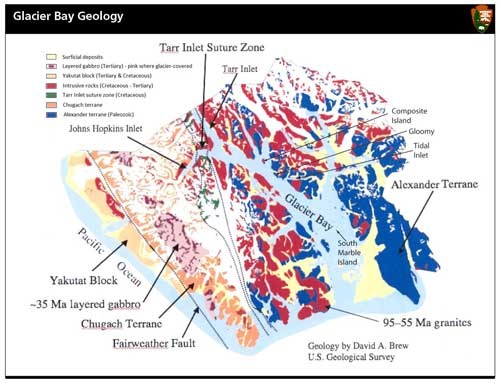
Alaska is mostly made up of massive groups of rocks that are essentially slices of tectonic plates that have been tranported and attached onto the western margin of the North American plate as a result of these tectonic processes. These slices of the Earth's crust referred to as terranes carry with them evidence of the environments they formed in and the forces that have relocated, altered and uplifted them. Geologist use many pieces of evidence to understand their journey around the globe. Terranes are bounded by active or ancient faults that transported them to their present location. Portions of four terranes are found in the park – the Yakutat, Chugach, Wrangellia and Alexander terranes. One particular location where the complex geology of Glacier Bay's terranes come together is known as the Tarr Inlet Suture Zone.
The Yakutat terrane is the youngest, westernmost terrane in the park. The Yakutat terrane is bound by the Chugach-St. Elias (thrust) fault to the north, the Fairweather Queen Charlotte to the east and the Transition fault to the south. The Yakutat terrane is an oceanic plateau began accreting about 26 million years ago and is still accreting onto the North American plate today. Over half of the Yakutat terrane has been subducted with the Yakutat microplate.
The Chugach terrane is located east of the Fairweather-Queen Charlotte fault zone and is bounded by the Border Ranges fault/Tarr Inlet Suture zone to the east. The Fairweather Mountain range is mostly composed of rocks of the Chugach terrane and magmatic intrusions. The Chugach terrane, which began accreting along the western edge of the Wrangellia terrane around 230 million years ago, include a late Cretaceous complexly deformed accretionary wedge and late Triassic to late Cretaceous melange (fragmented jumble of large blocks of rock of various type) that formed during subduction.
The Alexander terrane is bordered by the Lynn Canal-Chatham Strait fault zone located east of the park and the Border Range fault zone/Tarr Inlet suture zone to the west. The Alexander terrane has the longest history with rocks over 500 million years old. Since that time it has been transported from an equatorial environment to its present high latitude location where it has been for about the last 100 million years. The Alexander and Wrangellia terranes both contain rocks that were formed by volcanic arc systems in an ocean basin and have evolved together since the late Paleozoic. They tell of a story of volcanic island lagoons, an extensive barrier reef complex and underwater avalanches of volcanic derived debris. These terranes contain fossil evidence of their earlier years in the tropics. |
Last updated: June 9, 2017
